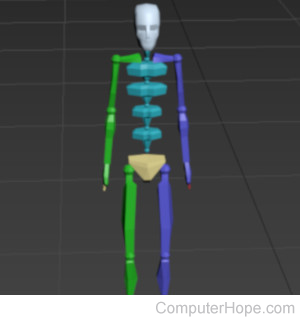Rigging

Rigging is a technique in 3-D animation to create lifelike movement in articulated bodies. Using animation software, the artist creates a virtual skeleton that defines how parts of a body are connected and how they move. The bones and joints are arranged in a parent-child hierarchy meaning children inherit position and rotation from their parents. Or, using inverse kinematics, the position of a child can affect a parent. For example, raising the wrist joint would cause the upper arm to rotate at the shoulder. Also, the elbow would bend at a natural angle.
The skeleton and its associated properties are called a rig. An artist who specializes in creating and applying rigs is called a character rigger.
Rigs can be created using animation tools, such as Maya, Houdini, or 3ds Max. Programming languages, such as Python, can be useful for generating rigs or controlling their behavior. Rigs for humanoid characters can be automatically created using Adobe's free autorigging software, Mixamo.
